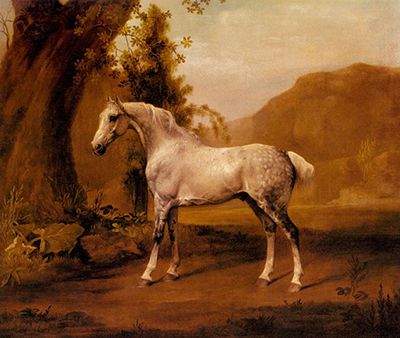A patron commissioned the painting A Grey Stallion in a Landscape as an appreciation of this horse. History has it that the picture showcases a horse that belonged to a pure-bred that was owned by the Earl of Egremont who raced during the years 1791-1794.
The horse is identified as Grey Trentham. Most of Stubbs' early pieces depicted horses with a jockey, groom or owner while those created in the 1780s and 1790s show a single horse in an isolated landscape. A Grey Stallion in a Landscape is one such painting, which shows a shimmering grey stallion in a densely wooded landscape. Its composition is somewhat simple as human presence or a luminous landscape does not enliven it. He painted a grey horse at full-length in a grassy landscape with a wooded landscape in the rear and grey stormy clouds above. It is also possible to see that Stubbs once placed a rider on this horse. The stark contrast between the dark background and the light-coloured horse is reminiscent of Stubbs' Horse and Lion artwork where he showcased a white stallion under attack in a cavernous landscape.
In this painting, Stubbs is not limited to one painting method but continually looks for other media. The most prominent here is romanticism along with experimental techniques. It is experimental because he uses an unusual mixture of pine resin and beeswax without applying drying oil on a wooden panel. Romanticism technique is also exhibited, though vaguely. He expresses as much passion and feeling towards the equine on the canvas and uses the wooded landscape in the background to set the animal apart from the rest to appreciate it for its success. It shows this animal was esteemed. The use of a grey horse in this picture shows a satisfying contrast between the stormy sky and its pale coat. Also, he introduces a line at the back of the neck to match the white clouds above. Again, unlike other equine pieces, this animal’s orientation is towards the left, which shows Stubbs' experimental nature.
Surprisingly, most of George Stubbs' techniques were largely self-taught. He only developed his great mastery of composition during his extensive travels throughout Italy. In this piece, he doesn't exhibit much detail as in previous equine artwork. The use of a rather dull shade of grey and the calm demeanour of the horse is somewhat sobering compared to previous pieces. Stubbs' primary goal when creating this portraiture is to showcase this animal’s personality.




